- 70,049
- 24,221
- Joined
- Aug 1, 2004
Why Your Next Louis Vuitton Bag May Hail From Texas
Matthew Dalton, Justin Clemons for The Wall Street Journal
20 hrs ago
https://www.linkedin.com/shareArtic...rce=http://a.msn.com/00/en-us/AAIWcpj?ocid=sl
http://a.msn.com/00/en-us/AAIWcpj?ocid=sf
https://twitter.com/share?url=http:...rer=http://a.msn.com/00/en-us/AAIWcpj?ocid=st
https://api.whatsapp.com/send?text=http://a.msn.com/00/en-us/AAIWcpj?ocid=sw
 © Justin Clemons for The Wall Street Journal
© Justin Clemons for The Wall Street Journal
ALVARADO, Texas—Louis Vuitton, the global luxury brand, was born on the cobblestones of Paris. Its future is taking shape in places like the grasslands of northeast Texas.
Where cattle graze, Louis Vuitton has built a 100,000-square-foot factory to make its monogrammed canvas and leather handbags for the American market.
Unlike Louis Vuitton products from France, the Texas bags won’t be produced by “petites mains,” the French artisans at the center of the brand’s history and mystique. Instead, Louis Vuitton is recruiting and training employees locally, no experience needed. Candidates passing drug and manual-dexterity tests can join the line with starting hourly pay of $13.
The gold-and-brown bags, priced at $1,200 and up, will be tagged “Made in the USA.”
Louis Vuitton is positioning itself for a world in which consumer tastes and global trade are in upheaval. That means testing one of the luxury industry’s core tenets—that a luxury product must be made where it was conceived. While competitors such as Gucci, Hermès and Chanel have kept most production in Italy and France, Louis Vuitton is increasingly letting industrial logic and geopolitics govern supply-chain decisions.
“It is an art form to maintain your company values and standards when you start expanding outside your home country,” says Louis Vuitton Chief Executive Michael Burke. “Most companies fail at that.”
Get news and analysis on politics, policy, national security and more, delivered right to your inbox
In opening the plant a year before President Trump faces voters again, the firm is stepping into an unfamiliar spotlight. On Thursday, LVMH’s billionaire controlling shareholder, Bernard Arnault, will host Mr. Trump at the plant for a ribbon-cutting ceremony highlighting the president’s trade agenda of pushing corporations to move production to the U.S.
Located 40 miles southwest of Dallas in Johnson County, where Mr. Trump won 70% of the vote, the plant is expected to employ 500, up from its current staff of 150. Louis Vuitton expects to build a second workshop on the property, adding another 500 workers. It began selling Texas-made bags from temporary facilities there in 2017.
The Texas factory gives Louis Vuitton a hedge against the risk of trade disputes between the U.S. and European Union. The Trump administration has placed tariffs on a range of EU products as it seeks to rewrite the rules of global trade.
Related video: A $5,000 secondhand outfit? Inside luxury consignor The RealReal

HD
OFF
A $5,000 Secondhand Outfit? Inside Luxury Consignor The RealReal
Luxury handbags have been spared thus far, but they were collateral damage in trans-Atlantic trade disputes in the 1990s. Since then, U.S. sales have helped power the brand’s owner, LVMH Moët Hennessy Louis Vuitton SE, to record revenues. LVMH doesn’t break out Louis Vuitton’s sales. Analysts estimate its annual revenue at more than $12 billion. Sales at Louis Vuitton’s stores are up double digits this year, Mr. Burke says.
Brands across the industry have long promoted their old-world craftsmanship to justify high prices. Hermès, maker of handbags costing more than $10,000, produces exclusively in France, where one worker oversees a single bag.
Louis Vuitton’s strategy is to sell luxury goods to the masses without lowering prices. It must stay on top of trends in far-flung markets, where consumers increasingly demand customized products. That raises pressure to streamline manufacturing and build an agile supply chain. Eight of its 24 manufacturing facilities are outside France.
It divides bag construction into steps, each performed by small teams of workers. Some teams select and cut leather. Others attach linings or sew together pieces of leather or canvas that form the body.
“It’s not like what you hear, this fiction—the same motions, on the same bag, for an entire life” of the worker, says Louis Vuitton’s Mr. Burke. “That’s really a romantic myth.”
Some Louis Vuitton customers prefer Made in France to Made in the USA, says Lori Matthews, a collector of Louis Vuitton bags who says she owns 15 to 20 bags from the brand. They think the French models are better constructed, she says, but she doesn’t believe it. “People look at these bags, practically under a microscope,” she says of collectors. “Every stitch and every seam.”
At times, Louis Vuitton’s Texas foray has pushed the boundaries of what separates the making of luxury goods from any other product. Two years ago, it set up temporary workshops to train employees and start production. Some early hires recall working through sweltering heat without air conditioning, surrounded by a chain-link fence. “It was literally a sweatshop,” says Amy Wynn, a Louis Vuitton worker in Texas until she says she was fired in August for poor performance, which she disputes. “It was brutally hot.”
A company executive acknowledges there wasn’t air conditioning but says the company brought in fans, declining to comment on Ms. Wynn’s tenure.
Another employee, fired in March—she says she was told it was “for safety concerns”—filed a complaint with the Texas Workplace Commission alleging the lack of air conditioning and other working conditions were a form of discrimination against the Hispanic and female workforce. Louis Vuitton declined to comment on the pending complaint.
“We’re typically not known for unsanitary conditions,” Mr. Burke says.
The company brought in Sébastien Bernard-Granger to oversee manufacturing in Texas and ensure the facilities, including the new plant, met French standards. Working conditions improved, some of the former employees say, as the brand moved into the permanent plant.
Founded in 1854, Louis Vuitton licensed its name to a U.S. manufacturer in the 1970s, later opening workshops in Spain, Romania and Portugal, and another in California in 2011. The far-flung operations let it adapt production to market demand. Inside the workshops, employees rotate through different steps of production and different models, allowing managers to redirect teams quickly to better selling models. That flexibility also allows it to make small batches of uniquely designed handbags, often based on individual consumers’ demands.
“We are moving from a sort of mass market,” says Antonio Belloni, LVMH’s managing director, “to a market of one.”
In January 2017, after meeting Mr. Trump at Trump Tower following the election, Mr. Arnault stepped out of the elevators with Mr. Trump and said Louis Vuitton might build a factory in the Carolinas or Texas.
“And maybe in the Midwest,” Mr. Trump suggested.
Louis Vuitton started negotiating with officials in North Carolina and in Johnson County, where it was eyeing a 260-acre ranch that kept zebras and other wild animals. The nearest town, sparsely populated, has at least five churches lining the highway and a store named Crazy Gun Dealer.
Louis Vuitton chose Johnson County because of its central location in the U.S., direct flights between Dallas and Paris, and direct access to the Port of Houston, where the brand will bring in raw materials, Mr. Burke says. It is also receiving tax incentives and a state pledge to resurface a road to the highway.
It sold most of the animals to zoos, keeping 14 heifers and adding a bull named Michael.
Workers need only a few weeks’ training before starting on a production line. Cindy Keele knew little about Louis Vuitton when she heard it was hiring. Having worked 20 years as a building-services-company administrator, she wanted away from the desk and figured her hobby of making leather saddles and cowboy vests might prove useful.
After 10 months at Louis Vuitton, she helps assemble the Palm Springs bag, which retails at $2,000 and up. “I needed something where I was up and moving,” she says.
The Texas workshop has Louis Vuitton considering a shake-up of its traditional supply chains, Mr. Burke says. For now, it plans to ship in raw materials from European suppliers, but would like to start buying U.S. leather. The challenge, he says, will be to persuade Texas ranchers to stop using barbed-wire fences that scar the cattle: “That typically makes it impossible for us to use the hides.”
He would also like to introduce products made exclusively at the ranch: “I don’t exclude us in the future making boots in Texas.”
Write to Matthew Dalton at Matthew.Dalton@wsj.com
Matthew Dalton, Justin Clemons for The Wall Street Journal
20 hrs ago
https://www.linkedin.com/shareArtic...rce=http://a.msn.com/00/en-us/AAIWcpj?ocid=sl
http://a.msn.com/00/en-us/AAIWcpj?ocid=sf
https://twitter.com/share?url=http:...rer=http://a.msn.com/00/en-us/AAIWcpj?ocid=st
https://api.whatsapp.com/send?text=http://a.msn.com/00/en-us/AAIWcpj?ocid=sw

ALVARADO, Texas—Louis Vuitton, the global luxury brand, was born on the cobblestones of Paris. Its future is taking shape in places like the grasslands of northeast Texas.
Where cattle graze, Louis Vuitton has built a 100,000-square-foot factory to make its monogrammed canvas and leather handbags for the American market.
Unlike Louis Vuitton products from France, the Texas bags won’t be produced by “petites mains,” the French artisans at the center of the brand’s history and mystique. Instead, Louis Vuitton is recruiting and training employees locally, no experience needed. Candidates passing drug and manual-dexterity tests can join the line with starting hourly pay of $13.
The gold-and-brown bags, priced at $1,200 and up, will be tagged “Made in the USA.”
Louis Vuitton is positioning itself for a world in which consumer tastes and global trade are in upheaval. That means testing one of the luxury industry’s core tenets—that a luxury product must be made where it was conceived. While competitors such as Gucci, Hermès and Chanel have kept most production in Italy and France, Louis Vuitton is increasingly letting industrial logic and geopolitics govern supply-chain decisions.
“It is an art form to maintain your company values and standards when you start expanding outside your home country,” says Louis Vuitton Chief Executive Michael Burke. “Most companies fail at that.”
Get news and analysis on politics, policy, national security and more, delivered right to your inbox
In opening the plant a year before President Trump faces voters again, the firm is stepping into an unfamiliar spotlight. On Thursday, LVMH’s billionaire controlling shareholder, Bernard Arnault, will host Mr. Trump at the plant for a ribbon-cutting ceremony highlighting the president’s trade agenda of pushing corporations to move production to the U.S.
Located 40 miles southwest of Dallas in Johnson County, where Mr. Trump won 70% of the vote, the plant is expected to employ 500, up from its current staff of 150. Louis Vuitton expects to build a second workshop on the property, adding another 500 workers. It began selling Texas-made bags from temporary facilities there in 2017.
The Texas factory gives Louis Vuitton a hedge against the risk of trade disputes between the U.S. and European Union. The Trump administration has placed tariffs on a range of EU products as it seeks to rewrite the rules of global trade.
Related video: A $5,000 secondhand outfit? Inside luxury consignor The RealReal

HD
OFF
A $5,000 Secondhand Outfit? Inside Luxury Consignor The RealReal
Luxury handbags have been spared thus far, but they were collateral damage in trans-Atlantic trade disputes in the 1990s. Since then, U.S. sales have helped power the brand’s owner, LVMH Moët Hennessy Louis Vuitton SE, to record revenues. LVMH doesn’t break out Louis Vuitton’s sales. Analysts estimate its annual revenue at more than $12 billion. Sales at Louis Vuitton’s stores are up double digits this year, Mr. Burke says.
Brands across the industry have long promoted their old-world craftsmanship to justify high prices. Hermès, maker of handbags costing more than $10,000, produces exclusively in France, where one worker oversees a single bag.
Louis Vuitton’s strategy is to sell luxury goods to the masses without lowering prices. It must stay on top of trends in far-flung markets, where consumers increasingly demand customized products. That raises pressure to streamline manufacturing and build an agile supply chain. Eight of its 24 manufacturing facilities are outside France.
It divides bag construction into steps, each performed by small teams of workers. Some teams select and cut leather. Others attach linings or sew together pieces of leather or canvas that form the body.
“It’s not like what you hear, this fiction—the same motions, on the same bag, for an entire life” of the worker, says Louis Vuitton’s Mr. Burke. “That’s really a romantic myth.”
Some Louis Vuitton customers prefer Made in France to Made in the USA, says Lori Matthews, a collector of Louis Vuitton bags who says she owns 15 to 20 bags from the brand. They think the French models are better constructed, she says, but she doesn’t believe it. “People look at these bags, practically under a microscope,” she says of collectors. “Every stitch and every seam.”
At times, Louis Vuitton’s Texas foray has pushed the boundaries of what separates the making of luxury goods from any other product. Two years ago, it set up temporary workshops to train employees and start production. Some early hires recall working through sweltering heat without air conditioning, surrounded by a chain-link fence. “It was literally a sweatshop,” says Amy Wynn, a Louis Vuitton worker in Texas until she says she was fired in August for poor performance, which she disputes. “It was brutally hot.”
A company executive acknowledges there wasn’t air conditioning but says the company brought in fans, declining to comment on Ms. Wynn’s tenure.
Another employee, fired in March—she says she was told it was “for safety concerns”—filed a complaint with the Texas Workplace Commission alleging the lack of air conditioning and other working conditions were a form of discrimination against the Hispanic and female workforce. Louis Vuitton declined to comment on the pending complaint.
“We’re typically not known for unsanitary conditions,” Mr. Burke says.
The company brought in Sébastien Bernard-Granger to oversee manufacturing in Texas and ensure the facilities, including the new plant, met French standards. Working conditions improved, some of the former employees say, as the brand moved into the permanent plant.
Founded in 1854, Louis Vuitton licensed its name to a U.S. manufacturer in the 1970s, later opening workshops in Spain, Romania and Portugal, and another in California in 2011. The far-flung operations let it adapt production to market demand. Inside the workshops, employees rotate through different steps of production and different models, allowing managers to redirect teams quickly to better selling models. That flexibility also allows it to make small batches of uniquely designed handbags, often based on individual consumers’ demands.
“We are moving from a sort of mass market,” says Antonio Belloni, LVMH’s managing director, “to a market of one.”
In January 2017, after meeting Mr. Trump at Trump Tower following the election, Mr. Arnault stepped out of the elevators with Mr. Trump and said Louis Vuitton might build a factory in the Carolinas or Texas.
“And maybe in the Midwest,” Mr. Trump suggested.
Louis Vuitton started negotiating with officials in North Carolina and in Johnson County, where it was eyeing a 260-acre ranch that kept zebras and other wild animals. The nearest town, sparsely populated, has at least five churches lining the highway and a store named Crazy Gun Dealer.
Louis Vuitton chose Johnson County because of its central location in the U.S., direct flights between Dallas and Paris, and direct access to the Port of Houston, where the brand will bring in raw materials, Mr. Burke says. It is also receiving tax incentives and a state pledge to resurface a road to the highway.
It sold most of the animals to zoos, keeping 14 heifers and adding a bull named Michael.
Workers need only a few weeks’ training before starting on a production line. Cindy Keele knew little about Louis Vuitton when she heard it was hiring. Having worked 20 years as a building-services-company administrator, she wanted away from the desk and figured her hobby of making leather saddles and cowboy vests might prove useful.
After 10 months at Louis Vuitton, she helps assemble the Palm Springs bag, which retails at $2,000 and up. “I needed something where I was up and moving,” she says.
The Texas workshop has Louis Vuitton considering a shake-up of its traditional supply chains, Mr. Burke says. For now, it plans to ship in raw materials from European suppliers, but would like to start buying U.S. leather. The challenge, he says, will be to persuade Texas ranchers to stop using barbed-wire fences that scar the cattle: “That typically makes it impossible for us to use the hides.”
He would also like to introduce products made exclusively at the ranch: “I don’t exclude us in the future making boots in Texas.”
Write to Matthew Dalton at Matthew.Dalton@wsj.com

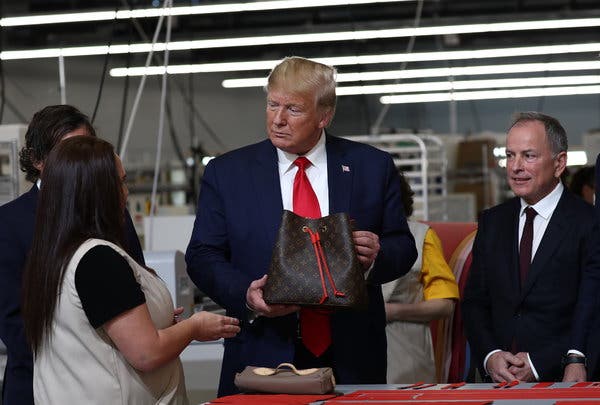

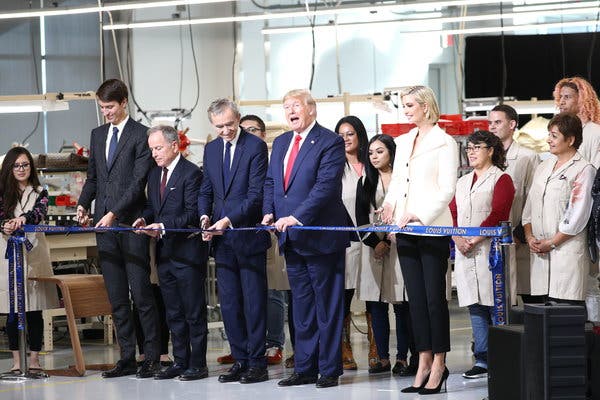
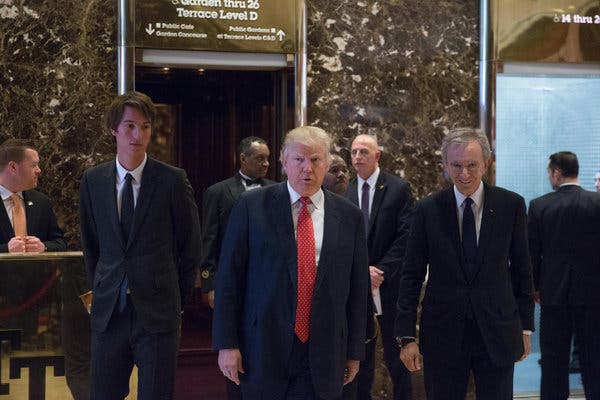
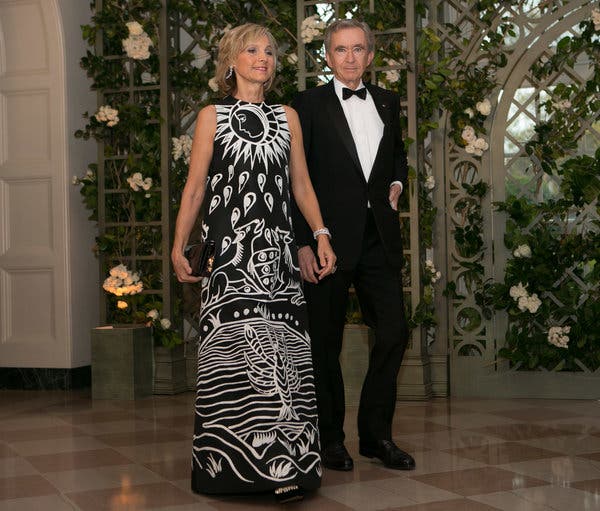
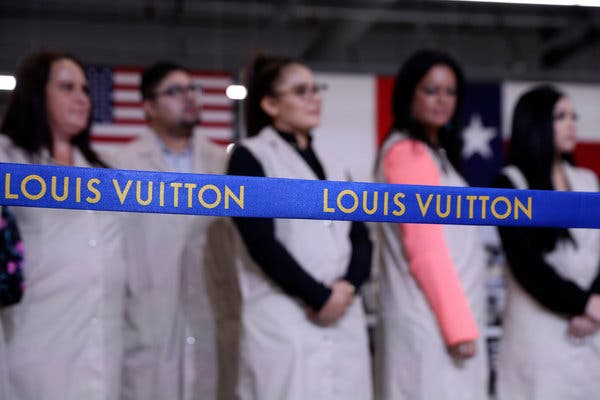

 https://wwd.com/fashion-news/fashion-scoops/president-trump-bernard-arnault-louis-vuitton-factory-jefferson-county-texas-1203343867/ …
https://wwd.com/fashion-news/fashion-scoops/president-trump-bernard-arnault-louis-vuitton-factory-jefferson-county-texas-1203343867/ …



